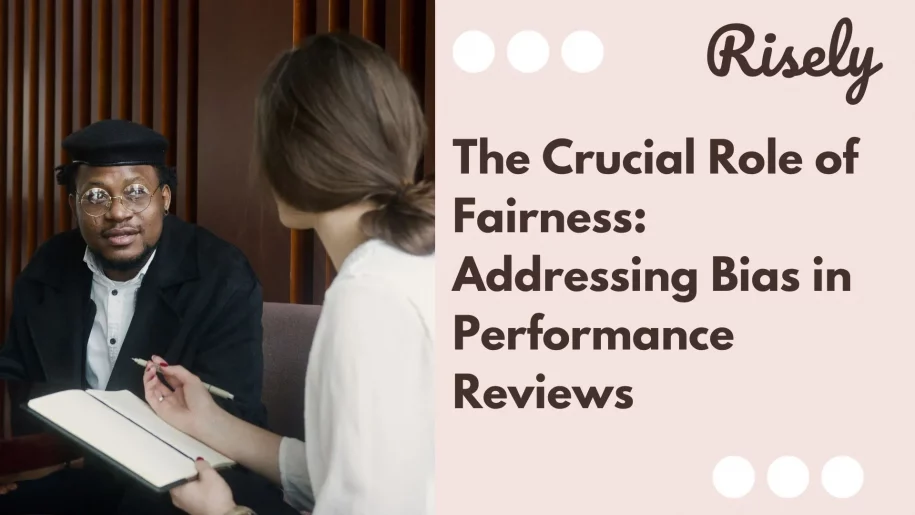The Crucial Role of Fairness: Addressing Bias in Performance Reviews
In the intricate dance of talent management, performance reviews are the spotlight. They illuminate an employee’s journey, casting a critical eye on achievements, milestones, and areas for growth. But, hidden beneath the surface, a lurking factor can distort this spotlight—the omnipresent specter of bias. This illuminating blog delves into the complex and often overlooked realm of bias in performance reviews. From gender and racial biases to the subtle influences that sway assessments, in this blog, we will explain the various forms bias can take and its profound impact on individuals and organizations. Keep reading as we unveil the veil that shrouds bias in performance reviews.What is a bias?
Bias is the systematic and often unconscious inclination or prejudice favoring or against a particular person, group, thing, or idea. It involves a deviation from impartiality, fairness, or objectivity, leading to judgments or actions that are influenced by factors unrelated to the merits of the situation. Bias can manifest in various forms, affecting decision-making, perceptions, and behaviors. Bias can be rooted in cultural, social, cognitive, or psychological factors, impacting various aspects of life, including hiring decisions, workplace evaluations, academic assessments, healthcare, and more. Recognizing and addressing bias ensures fairness, equity, and objectivity in decision-making.What is bias in performance reviews?
Bias in performance reviews refers to unfair or discriminatory judgments and evaluations that can influence an employee’s job performance assessment. Bias can occur when performance reviews are influenced by factors unrelated to an employee’s performance, skills, and contributions. These biases can affect positive and negative feedback, leading to inaccurate and unfair assessments. Bias in performance reviews can have serious consequences for employees, affecting their career advancement, compensation, and overall job satisfaction. Additionally, it can create a toxic work environment, decrease morale, and lead to issues related to diversity and inclusion.Types of Bias in Performance Reviews
Bias in performance reviews can manifest in various ways, affecting the fairness and accuracy of assessments. Some common types of bias in performance reviews are:- Gender bias: It can occur when an employee’s gender influences how they are evaluated. Stereotypes and expectations related to gender can lead to differential treatment in performance reviews. Example: Assuming that men are more assertive and better suited for leadership roles leads to more favorable evaluations of male employees in leadership positions.
- Racial bias: It involves making judgments based on a person’s race or ethnicity rather than their actual performance. Prejudices and stereotypes about specific racial or ethnic groups can influence evaluations. Example: An employee of a particular racial or ethnic background is rated lower than their peers despite similar or superior performance.
- Confirmation bias: This is the tendency to focus on and remember information that confirms preexisting beliefs about an employee while ignoring or downplaying evidence that contradicts those beliefs. Example: A manager who believes an employee is unproductive may unconsciously seek out and remember instances of low productivity while overlooking instances of high productivity.
- Halo effect: This bias occurs when an overall positive impression of an employee influences the perception of their skills and contributions. It can lead to exaggerated positive evaluations. Example: A manager who generally likes an employee may rate all aspects of their performance higher than warranted, even if specific areas need improvement.
- Leniency or severity bias: When a reviewer consistently rates all employees higher than they deserve, severity bias is the opposite, where all employees receive lower ratings. This can happen due to a reluctance to provide honest feedback. Example: A manager who avoids giving low ratings to avoid conflict, resulting in all employees receiving above-average scores, regardless of their actual performance.
- Recency bias: This bias occurs when recent events or behaviors disproportionately influence performance ratings, overshadowing an employee’s performance over a more extended period. Example: A manager may give excessive weight to a recent mistake made by an employee, leading to a lower rating, even if the employee has a history of excellent performance.
- Central tendency bias: It involves avoiding extreme ratings, resulting in most employees receiving average or mediocre scores, even if their performance warrants higher or lower ratings. Example: A manager consistently rates all employees as “meets expectations” or “satisfactory,” failing to differentiate between exceptional and underperforming individuals.
- Similarity bias: It occurs when a reviewer favors employees who are similar in background, interests, or values, leading to favorable treatment for those who resemble them. Example: A manager may treat employees who share their hobbies or interests with preferential treatment, regardless of their job performance.
Other Interesting Reads
Why is addressing bias in performance reviews important?
Addressing bias in performance reviews is critically important for several reasons:- Fairness and equity: Bias in performance reviews can result in unequal treatment of employees based on factors unrelated to their job performance, such as gender, race, age, or personal relationships. Addressing bias ensures that all employees have an equal opportunity to be evaluated fairly.
- Employee morale: Biased performance reviews can lead to frustration, demotivation, and a sense of injustice among poorly assessed employees. This can negatively impact overall morale and job satisfaction.
- Talent development: Fair and unbiased performance reviews provide employees with clear feedback on their strengths and areas for improvement. This feedback is essential for personal and professional growth, skill development, and career advancement.
- Retention: Biased performance reviews can lead to the loss of talented employees who feel undervalued or unfairly treated. Addressing bias can help retain valuable talent within the organization.
- Legal compliance: Discriminatory practices in performance reviews can expose organizations to legal risks and liabilities. Proactively addressing bias helps ensure compliance with anti-discrimination laws and regulations.
- Improved decision-making: Unbiased performance reviews provide accurate data for talent management decisions, such as promotions, compensation adjustments, and succession planning. This improves the overall quality of decision-making within the organization.
- Productivity and innovation: A workplace free from bias allows employees to focus on their work and contribute their best ideas and efforts. It fosters a culture of innovation and productivity.
Ways managers can avoid bias in performance reviews
Managers can take several steps to avoid bias in performance reviews, ensuring that assessments are fair, accurate, and objective:- Use clear and specific criteria: Establish well-defined and measurable criteria for performance evaluation. Ensure that these criteria are communicated to employees so they understand what is expected.
- Implement structured review processes: Adopt structured performance reviews that provide a consistent evaluation framework. Structured formats with predefined questions and rating scales help reduce subjectivity.
- Training and awareness: Train managers and reviewers on recognizing and mitigating bias, including unconscious bias. Understanding common biases can help individuals avoid falling into these traps.
- Standardize documentation: Encourage managers to document performance-related incidents and achievements throughout the year. This documentation should be specific, objective, and related to the established criteria.
- Use multiple assessors: Whenever possible, involve multiple assessors or reviewers in the evaluation process. Multiple perspectives can help balance individual biases.
- Avoid comparisons: Refrain from making direct comparisons between employees. Instead, evaluate each employee independently based on their performance against established criteria.
- Balance feedback: Ensure that performance reviews include a balance of positive and constructive feedback, areas for improvement, and specific examples. Avoid overly positive or negative language.
Conclusion
As we conclude our blog on bias in performance reviews, it’s abundantly clear that this topic is far from superficial. Whether overt or subtle, conscious or unconscious, bias can cast long shadows over the entire talent evaluation process, impacting individuals and organizations in profound ways. In the end, bias in performance reviews is a manageable challenge. It’s a mountain we can climb, provided we do so together. By working collaboratively, acknowledging our biases, and actively seeking to eliminate them, we can ensure that the spotlight of performance reviews shines brightly on merit, achievement, and growth.Ready to foster fairness and growth in performance reviews?
Take our free constructive feedback assessment and pave the way to unbiased, impactful evaluations!
Other Related Blogs
5 Unique Benefits Of Online Leadership Coaching
5 Unique Benefits Of Online Leadership Coaching Remember the days of leadership development being confined to a stuffy conference room filled with flipcharts and generic advice? Yeah, those days are…
Performance Management Training: Empowering Managers To Manage Better
Performance Management Training: Empowering Managers To Manage Better Remember that feeling of dread when you knew performance review season was rolling around? Yeah, us, too. For many employees, performance reviews…
Manager Development Goals And How To Reach Them: Opportunities And Areas To Focus On
Manager Development Goals And How To Reach Them: Opportunities And Areas To Focus On You’ve meticulously crafted a development program for your high-potential employees, but their managers just aren’t on…
Grooming for Management: The Key to Building a Sustainable Leadership Pipeline
Grooming for Management: The Key to Building a Sustainable Leadership Pipeline Imagine a crucial leadership position opening up in your organization. You scramble to fill the role, internally and externally,…


